LME Week debates shifting commodities dynamics
Members of the base metals community gathered at the Hong Kong Exchange's first LME event in Hong Kong, with many bearish short-term, yet positive on the long-term growth story.

China’s transformation from an export- to a consumer-driven economy will have a knock-on effect across a variety of industries in the country, and base metals are no exception.
Sign In to Your Account
Access Exclusive AsianInvestor Content!
Please sign in to your subscription to unlock full access to our premium AI resources.
Free Registration & 7-Day Trial
Register now to enjoy a 7-day free trial—no registration fees required. Click the link to get started.
Note: This free trial is a one-time offer.
¬ Haymarket Media Limited. All rights reserved.


